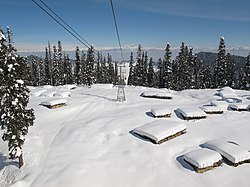
Kullu is a district in Himachal Pradesh, India. It borders Shimla district to the south, Mandi and Kangra districts to the west, Kinnaur to the east and the Lahaul and Spiti district to the north and east. The largest valley in this mountainous district is the Kullu Valley. The Kullu valley follows the course of the Beas River, and ranges from an elevation of 833 m above sea level at Aut to 3330 m above sea level at the Atal Tunnel South Portal, below the Rohtang Pass. The town of Kullu, located on the right side of the Beas River, serves as the administrative headquarters of the Kullu district. The Kullu district also incorporates several riverine tributary valleys of the Beas, including those of the Parvati, Sainj, and Tirthan rivers, and thus some regions somewhat distant from the Kullu valley. The economy of the district relies mainly on horticulture, agriculture, tourism, and traditional handicrafts.
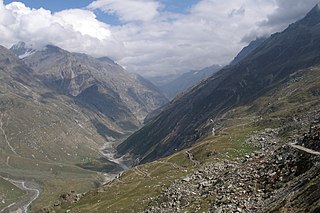
Rohtang Pass is a high mountain pass on the eastern end of the Pir Panjal Range of the Himalayas around 51 km (32 mi) from Manali in the Indian state of Himachal Pradesh. It connects the Kullu Valley with the Lahaul and Spiti Valleys of Himachal Pradesh, India.

A hill station is a town located at a higher elevation than the nearby plain or valley. The English term was originally used mostly in colonial Asia, but also in Africa, for towns founded by European colonialists as refuges from the summer heat and, as Dale Kennedy observes about the Indian context, "the hill station (...) was seen as an exclusive British preserve: here it was possible to render the Indian into an outsider". The term is still used in present day, particularly in India, which has the largest number of hill stations, most are situated at an altitude of approximately 1,000 to 2,500 metres.
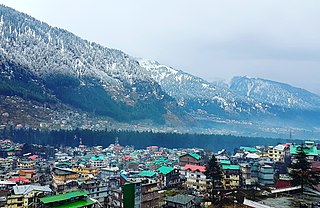
Manali is a town, near Kullu town in Kullu district in the Indian state of Himachal Pradesh. It is situated in the northern end of the Kullu Valley, formed by the Beas River. The town is located in the Kullu district, approximately 270 kilometres (170 mi) north of the state capital of Shimla and 544 kilometres (338 mi) northeast of the national capital of New Delhi. With a population of 8,096 people recorded in the 2011 Indian census Manali is the beginning of an ancient trade route through Lahaul (H.P) and Ladakh, over the Karakoram Pass and onto Yarkand and Hotan in the Tarim Basin of China. Manali is a popular tourist destination in India and serves as the gateway to the Lahaul and Spiti district as well as the city of Leh in Ladakh.

Gulmarg, known as Gulmarag in Kashmiri, is a town, hill station, popular tourist destination, popular skiing destination and a notified area committee in the Baramulla district in the Indian union territory of Jammu and Kashmir. It is located at a distance of 31 km (19 mi) from Baramulla and 49 km (30 mi) from Srinagar. The town is situated in the Pir Panjal Range in the Western Himalayas and lies within the boundaries of Gulmarg Wildlife Sanctuary.
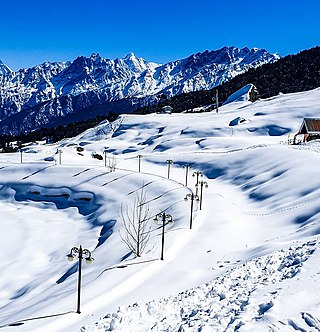
Auli is in Chamoli district in the Himalayan mountains of Uttarakhand, India. Auli, also known as Auli Bugyal, in Garhwali, which means "meadow", is located at an elevation of 2,800 metres (9,200 ft) above sea level. Between June and October, the valley has one of highest numbers of flower species found anywhere in the world, with 520 species of high-altitude plants, 498 of which are flowering plants with significant populations of endangered species.
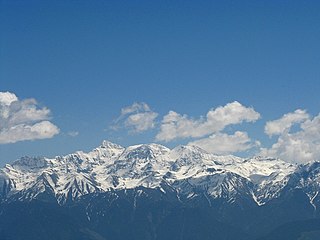
The Pir Panjal Range is a chain of mountains in the Lower Himalayan region located in the Western Himalayas of northern Indian subcontinent. It runs southeast to northwest between the Beas and Neelam/Kishanganga rivers, in the Indian territory of Himachal Pradesh and disputed Jammu and Kashmir, with its northwestern end extending into Pakistan. The Himalayas show a gradual elevation towards the Dhauladhar and Pir Panjal ranges. Pir Panjal is the largest range of the Lesser Himalayas. Near the bank of the Sutlej River, it dissociates itself from the Himalayas and forms a divide between the Beas and Ravi rivers on one side and the Chenab on the other. Further west, the Pir Panjal range separates the Kashmir Valley from the hills of Jammu region.

The state of Himachal Pradesh is spread over an area 55,673 km2 (21,495 sq mi) and is bordered by Jammu and Kashmir and Ladakh on the north, Punjab on the southwest, Haryana on the south, Uttarakhand on the southeast, a small border with Uttar Pradesh in the south, and Tibet on the east. Entire Himachal Pradesh lies in the mountainous Himalaya region, rich in natural resources
Himachal Pradesh, although railways and airways serve very limited transport needs, the road network of the state serves the transport needs of the people. Although, the geography of Himachal presents considerable challenge to the development of transport infrastructure, it has the highest road density among all the Hill States of India. Himachal also has 3 airports, 2 narrow gauge rail tracks and couple of other under-construction broad gauge railway tracks, but roads remain the main mode of transport.
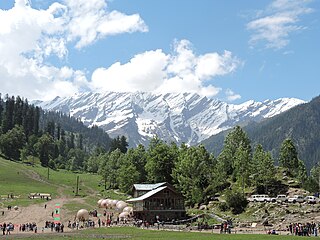
Solang Valley derives its name from a combination of the words Solang and Nallah. It is a side valley at the top of the Kullu Valley in Himachal Pradesh, India 14 km northwest of the resort town Manali on the way to Rohtang Pass, and is known for its summer and winter sports conditions. The sports most commonly offered are parachuting, paragliding, skating, and zorbing.
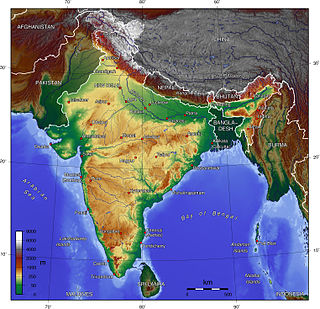
The Indian Himalayan Region is the section of the Himalayas within the Republic of India, spanning thirteen Indian states and union territories, namely Ladakh, Jammu and Kashmir, Himachal Pradesh, Uttarakhand, Sikkim, West Bengal, Manipur, Meghalaya, Mizoram, Nagaland, Tripura, Assam, and Arunachal Pradesh. The region is responsible for providing water to a large part of the Indian subcontinent and contains various flora and fauna.

Sach Pass is a 4,414-metre-high (14,482 ft) mountain pass in Chamba District, Himachal Pradesh, India on the Pir Panjal range of the Himalayas. It is 127 km (79 mi) from the District Headquarters. It connects the Chamba valley with the Pangi valleys of Himachal Pradesh, India. There is a helipad on the ascent towards Sach pass from Bairagarh of Himachal Pradesh.
Winter sports are common in India in the Himalayan areas. Ski tournaments take place every winter in Gulmarg, Kashmir and Manali. Winter sports are generally more common in the northern states of Jammu and Kashmir, Himachal Pradesh, Uttarakhand, Sikkim and Arunachal Pradesh. Skiing, snow rugby, snow cycling and snow football are few of the common sports played in India. Skiing is more popular although India has taken part in Luge in Winter Olympics since 1998. The Bandy Federation of India is headquarters are in Mandi in Himachal Pradesh. Luge is practiced in a big way by the mountain residents in an improvised form called 'Reri'.
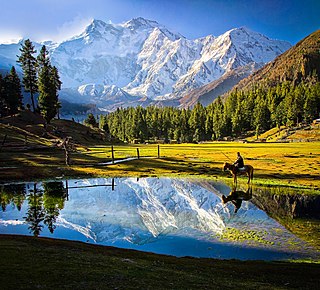
The Western Himalayas refers to the western half of the Himalayas, in northwestern India and northern Pakistan. Four of the five tributaries of the Indus River in Punjab rise in the Western Himalayas; while the fifth, the Sutlej cuts through the range after rising in Tibet.
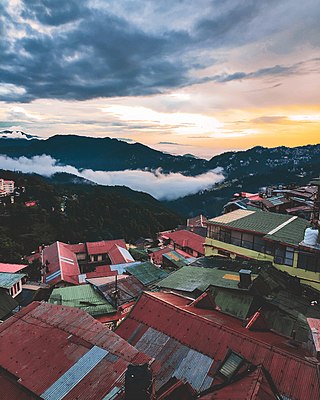
Tourism in Himachal Pradesh relates to tourism in the Indian state of Himachal Pradesh. This is popularly renowned for its Himalayan landscapes and popular hill-stations. Many outdoor activities such as rock climbing, mountain biking, paragliding, ice-skating, trekking, rafting, and heli-skiing are popular tourist attractions in Himachal Pradesh.
Hanuman Tibba is the highest mountain peak in Kangra district and lies on Dhauladhar Range in Himachal Pradesh, with an altitude of 5,982 metres (19,626 ft) above sea level. It lies to the Northwest of Manali and to the East of Solang. To the north of Hamuman Tibba, lies the Taintuka Pass and to the south lies Manali Pass. These Passes form the district boundary between the Kangra District and Kullu District. It is a well known local peak, partly due to it resembling a steep pyramid, with its noted feature of steep vertical rise from its base camp site. Its west face has been a recent site to many attempts to climb through the “west spur”, a steep, technical, sustained rocky feature often exposed to winds and gnarly ice flutings. The Diretissima through this face and the north face- overall, is still unclimbed. In a noted recent attempt by the Alpine Club of the Greater Himalayas, 4 alpinists tried climbing through this very spur, but were defeated by rotten ice conditions, high at 5,720 m (18,770 ft).
Govind Singh Thakur is an Indian politician. He was elected to the Himachal Pradesh Legislative Assembly from Manali in the 2007, 2012 and 2017 Himachal Pradesh Legislative Assembly election as a member of the Bharatiya Janata Party. He held the chair as Minister of Forest, Transport, Youth Services and Sports till 31 July 2020, he was Education & Language and Culture Minister in Jai Ram Thakur cabinet.

The ropeway in India is a public transportation system where cabins, gondolas or open chairs are hauled above the ground with the help of cables. India's Parvatmala Scheme, the world's largest ropeway project, envisages spending ₹1,250 billion (US$16 billion) in public–private partnership (PPP) mode over five years till 2030 to build 200 new ropeway projects of more than 1200 km length, which will decongest the traffic in narrow roads of big cities and provide cheaper connectivity in mountainous and touristy areas. Since 30% of India is covered by mountains, the ropeways are specially useful in mountainous areas, where it is difficult to build roads or railway, as lower cost and higher Return on investment (ROI) projects. Rajgir Ropeway in Bihar, 333m-long chairlift ropeway built in 1960s, is India's first ropeway. As of 2024, the 4km-long Auli Ropeway in Uttarakhand is India's longest and world's the second-longest ropeway behind Vietnam's 7,899.9 m long Hòn Thơm cable car, and when completed the under-construction 5.5km-long Mussoorie-Dehradun Ropeway will be the longest in India. Kashi ropeway is India's first urban ropeway, and world's third urban public transport ropeway behind Bolivia's Mi Teleférico opened in 2014 and Mexico City's Mexicable opened in 2021. This article also contains a list of "glass bridges in India", which are mostly glass bridge skywalk.
Sahil Thakur is an alpine skier from Himachal Pradesh. He represented India at the 2024 Winter Youth Olympic Games in Gangwon, South Korea from 19 January to 1 February 2024. He is only the third Indian to compete in the Youth Olympics. Aanchal Thakur took part in the inaugural 2012 Winter Youth Olympics in Austria and in 2016, Saurabh took part in the super-G, Giant Slalom, Slalom.
